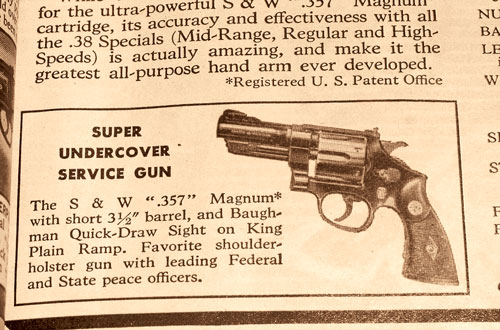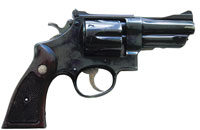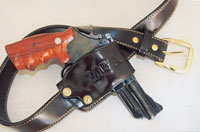
I took a cherry (as-new, apparently unfired) Model 27-2 to the range and set up some NRA bulls-eye targets scaled for the 25-yard distance I was using. With me were three classic loads by three justly famous manufacturers, in as many different bullet weights.
First was the mild .38 Special 148-grain mid-range Match wadcutter load by Federal, which has been called the Gold Standard for accuracy in handgun ammunition. I used an MTM rest and, because this specimen of the Model 27 had the wide target trigger and beavertail hammer intended for single action shooting, I fired it that way. Recoiling with a gentle bump at each shot, the pristine pinned and recessed Model 27-2 put five rounds in 1.15 inches.

Curiously, four of the five bullet holes exhibited slight yawing of the projectiles. The best three shots in the group, a measurement that generally factors out enough human error to give me a good idea what the gun could have done for all five shots from a machine rest, was 0.60 inch. All measurements were done to the nearest 0.05 inch.
The most famous “manstopper” in the history of the .357 Magnum cartridge is unquestionably the 125-grain semi-jacketed hollow point. I used Winchester. The uniform group measured 1.25 inches for all five, and 0.70 inch for the best three hits.
158s grain was the original weight of the .357 Magnum bullet, and is still very popular. Black Hills ammo, using Remington’s 158-grain scallop-jacketed hollow point was my choice here. The 27-2 sent the quintet of 158-grain Magnums into 1.70 inches (measured center to center between the farthest bullet holes, like all groups here). The three tightest hits were 0.80 inch apart.
This is par for the course with a Model 27, and I’ve seen some that would put five consecutive shots under an inch at this distance with loads they liked best. Almost from the beginning, the big Smith & Wesson .357 proved itself accurate enough for bulls-eye shooting, and in the 1970s in the early days of IHMSA (the International Handgun Metallic Silhouette Association), the 8-3/8-inch barrel version was often the winning gun on the firing line. In IHMSA, remember, we’re talking about knocking down steel rams at 200 paces, using iron sights.

The tradition continues. In mid-2006, I tested the Smith & Wesson 327 tactical model, introduced at the SHOT Show a few months earlier, flashlight rail and TruGlo red dot sight and all. Two of the loads I used were from the same lots as those I had accuracy tested in the 27-2. The .38 Special Federal Match wadcutters put five keg-shaped 148-grain slugs into 1.65 inches, with the best three in 1.20 inches. With the Black Hills .357 Magnum loads, all five shots were in four fifths of an inch, and within that 0.80 inch five-shot group the best three shots clustered exactly half an inch apart, center to center.
Smith & Wesson built the original large frame .357 Magnum to be accurate. More than 70 years later, their new ones apparently still are.
Shooting the Model 27
Today’s N-frame .357 cylinders hold eight rounds, but the original contained only six narrow chambers. With that little metal cut away, the cylinder was heavy. This had some interesting ramifications as to the gun’s handling and shooting characteristics.
It was, of course, heavy, so much so that Gaylord, famous as a holster maker, called the 3-1/2-inch Model 27 one of “the top heavy trio,” the other two being the 2-inch barrel versions of the S&W Model 10 and the .41-frame Colt Marshal. The Model 27 weighed about 44-1/2 ounces in the short form, and 48 ounces or so with its longest barrel.
That heavy six-round cylinder with its thick walls between chambers made the N-frame Smith a favorite for handloaders who experimented near the edge of red-line .357 Magnum loads. But it also made for a very fast, sure double action pull. Charles “Skeeter” Skelton noted that he particularly liked the feel of a Model 27 in fast double action shooting because the heavier cylinder seemed to gain momentum more quickly from the beginning of the trigger pull, making the end of the pull feel proportionally lighter with less resistance, because the cylinder hand required less mechanical effort to raise for cylinder rotation.
The deep frame gave a high bore axis. Over the years, I and others discovered that the Model 27’s muzzle actually jumped a little more than that of the much lighter Combat Magnum, whose barrel was lower and therefore much closer to the axis of the wrist. However, the weight of the N-frame absorbed more of the rearward kick of the recoil, making it a more comfortable gun to shoot, especially for long strings of fire. (The aforementioned Jerry Miculek began his spectacular competition career with an 8-3/8-inch S&W K-38. He told me he switched to the big N-frame Model 27 with the same long barrel, because his heavy “bowling pin loads” were killing his K-frames.)
The recessed chambers, which began in 1935 and continued late into the epoch of the Model 27, were prized by revolver aficionados. The reason was the exquisite machining that went into them. They served no actual purpose, according to most firearms engineers and experts, other than creating an illusion of more steel support for a high-powered cartridge.
In field use, they actually had a downside. Particles of unburned powder could find their way there as spent casings were ejected, creating a buildup that could prevent full insertion of the next cartridge. This could potentially lock up the gun.
Click here to read part I.
Click here to read part II.
Click here to read part IV.
This article is an excerpt from the new book Massad Ayoob's Greatest Handguns of the World. To learn more, Click Here.

Next Step: Get your FREE Printable Target Pack
Enhance your shooting precision with our 62 MOA Targets, perfect for rifles and handguns. Crafted in collaboration with Storm Tactical for accuracy and versatility.
Subscribe to the Gun Digest email newsletter and get your downloadable target pack sent straight to your inbox. Stay updated with the latest firearms info in the industry.

![Best Concealed Carry Guns In 2025 [Field Tested] Wilson Combat EDC X9S 1](https://gundigest.com/wp-content/uploads/Wilson-Combat-EDC-X9S-1-324x160.jpg)


![Best 9mm Carbine: Affordable PCCs [Tested] Ruger Carbine Shooting](https://gundigest.com/wp-content/uploads/Ruger-Carbine-Shooting-100x70.jpg)
![Best AR-15: Top Options Available Today [Field Tested] Harrington and Richardson PSA XM177E2 feature](https://gundigest.com/wp-content/uploads/Harrington-and-Richardson-PSA-XM177E2-feature-100x70.jpg)
